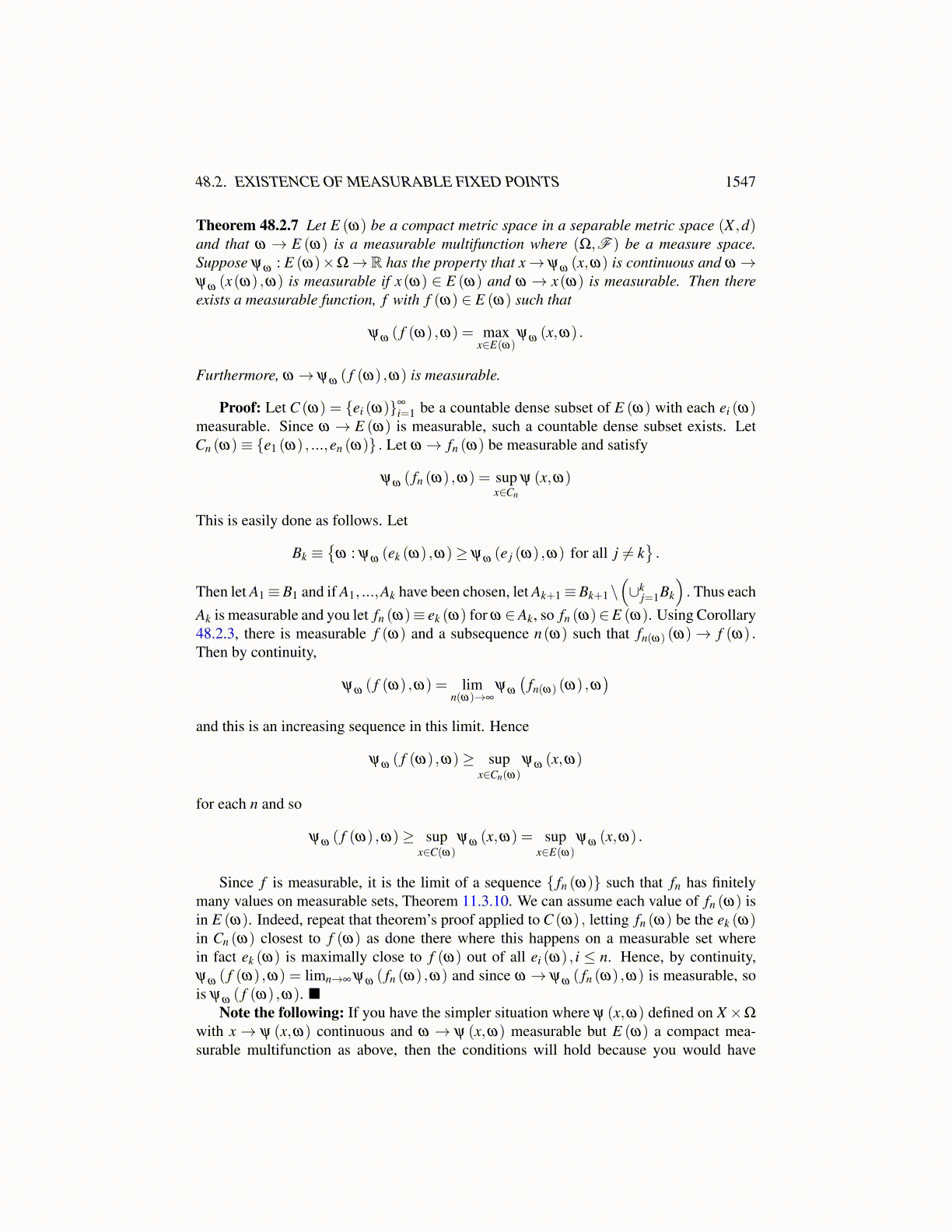
48.2. EXISTENCE OF MEASURABLE FIXED POINTS 1547
If F1 = Ω, then stop. If not, let
F2 ≡
{ω /∈ F1 :
n
∏i=0
p(yi,ω) = Pn
}: [y0, · · · ,yn] = S2
Continue this way obtaining disjoint measurable sets Fj whose union is all of Ω. Theunion is Ω because every ω is associated with at least one of the Si. Now for ω ∈ Fkand [y0, · · · ,yn] = Sk, it follows that ∏
ni=0 p(yi,ω) = Pn. For ω ∈ Fk, let b(ω) denote the
barycenter of Sk. Thus ω→ b(ω) is a measurable function, being constant on a measurableset. Thus we let b(ω) = ∑
mi=1 XFi (ω)bi where bi is the barycenter of Si.
Now do this for a sequence εk→ 0 where bk (ω) is a barycenter as above. By Lemma48.2.2 there exists x(ω) such that ω → x(ω) is measurable and a sequence{
bk(ω)
}∞
k(ω)=1 , limk(ω)→∞
bk(ω) (ω) = x(ω)
This x(ω) is also a fixed point.Consider this last claim. x(ω) = ∑
ni=0 ti (ω)xi and after applying f(·,ω) , the result is
∑ni=0 si (ω)xi. Then bk(ω) ∈ σ k (ω) where σ k (ω) is a simplex having vertices{
yk0 (ω) , · · · ,yk
n (ω)}
and the value of[yk
0 (ω) , · · · ,ykn (ω)
]is Pn. Re ordering these if necessary, we can assume
that the label for yki (ω) = pi which implies that, as noted above,
si (ω)
ti (ω)≤ 1, si (ω)≤ ti (ω)
the ith coordinate of f(yk
i (ω) ,ω)
with respect to the original vertices of S decreases andeach i is represented for i = {0,1, · · · ,n} . Thus
yki (ω)→ x(ω)
and so the ith coordinate of yki (ω) , tk
i (ω) must converge to ti (ω). Hence if the ith coordi-nate of f
(yk
i (ω) ,ω)
is denoted by ski (ω) ,
ski (ω)≤ tk
i (ω)
By continuity of f, it follows that ski (ω)→ si (ω) . Thus the above inequality is preserved
on taking k→ ∞ and so0≤ si (ω)≤ ti (ω)
this for each i. But these si add to 1 as do the ti and so in fact, si (ω) = ti (ω) for each i andso f(x(ω) ,ω) = x(ω). This proves the following theorem which gives the existence of ameasurable fixed point.
Theorem 48.2.4 Let S be a simplex [x0, · · · ,xn] such that {xi−x0}ni=1 are independent.
Also let f(·,ω) : S→ S be continuous for each ω and ω→ f(x,ω) is measurable, meaninginverse images of sets open in S are in F where (Ω,F ) is a measurable space. Then thereexists x(ω) ∈ S such that ω → x(ω) is measurable and f(x(ω) ,ω) = x(ω).